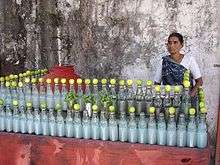Banta


Banta also known as Fotash Jawl in Bengali, Goli Soda (Goli = spherical object in Hindi) or Goti Soda (Goti = marble in Hindi) is a colloquial term for a carbonated lemon or orange-flavoured soft drink popular in India. Though the origin of its name is from Punjabi word for marble (banta), Banta has been sold since the late 19th century,[1][2] long before popular carbonated drinks arrived. The drink is often sold mixed with lemon juice, crushed ice, chaat masala and kala namak (black salt) as a carbonated variant of popular lemonades shikanjvi or jal-jeera.[1] It is available at street-sellers known as bantawallahs at prices ranging from ₹5 (7.8¢ US) - ₹30 (47¢ US).[3][4]
Similar to Ramune, a Japanese lemon drink,[4] Banta is popular across North India and especially the capital Delhi. In fact, it is known as "Delhi’s local drink", nimbu (lemon) soda or kanchay waali drink (kancha = marble in Hindi), especially in Old Delhi and the Delhi University college campuses.[3][5] In South India it is known as Goli Soda, due to the goli (marble) in neck of the bottle.[3] The states of Tamil Nadu and Andhra Pradesh have a local variant known as panneer soda that is flavoured with rose essence.[4]
Overview
Banta is available in a Codd-neck bottle, a heavy glass bottle whose mouth is sealed by a round marble (instead of a cap) thanks to the pressure of the carbonated contents. The distinctive bottle has led to the drink also being called goli soda in South India.[2]
The banta bottles are largely bottled by unorganized manufacturers, who sell bottles for as little as ₹2. Delhi itself has over 100 single-room bottling units.[1] During the bottling process, a chemical flavouring agent known as Lemon No. 1 by International Flavors & Fragrances (IFF) is added. The agent is also used in ice cream and by the pharmaceutical industry.[4]
Prior to India's independence the Codd-neck bottles were imported from England, however post-independence local manufacturers came up including many factories in Ahmedabad. Today a major Codd-neck bottle manufacturer in India is Khandelwal Glass Works (since 1981) at Sasni, Uttar Pradesh, after Mahalakshmi Glass Works in Hyderabad closed down a few years ago. Before the re-entry of popular soft drinks like Pepsi and Coca-Cola in 1993, the sale of Banta reached its peak in the early 1990s, selling 100,000 bags per annum, with each a bag containing 75 bottles each. By 2010 however the sales had dropped by nearly half, especially after reports of consumers experiencing nausea after consumption due to unsanitary conditions during production of the beverage.[4][6]
See also
References
- 1 2 3 Shreya Roy Chowdhury (1 Jul 2013). "Banta: Why the street drink is still popular in Delhi". The Economic Times. Retrieved 2014-08-17.
- 1 2 "Sipped for centuries". The Hindu. June 10, 2011. Retrieved 2014-08-17.
- 1 2 3 "Banter about Banta". The Hindu. April 19, 2013. Retrieved 2014-08-17.
- 1 2 3 4 5 Anuja & Krish Raghav (Jul 2, 2010). "Pop culture". Mint (newspaper). Retrieved 2014-08-17.
- ↑ Sinha, Namya (May 19, 2009). "My desi drink in Delhi". Hindustan Times. Archived from the original on 2014-08-19. Retrieved 2014-08-17.
- ↑ Yadav, Priya (Apr 25, 2002). "Your ‘banta’ bottle may have fly juice". The Times of India. Retrieved 2014-08-17.